Martin Gould, Giles Dickenson-Jones and Richard Wood1
A version of this paper was tabled as an Australian Government out-of-session Information Note at the Pacific Islands Forum Economic Ministers Meeting held on 19-21 July 2011 in Apia, Samoa.
Introduction
This note analyses the recent strong surge in international food and fuel prices and discusses the implications for Forum island countries (FICs). It identifies likely economic impacts and reviews policy options.
The note begins by separately analysing food prices in Part I and fuel prices in Part II. In each case, the note identifies the main reasons for the most recent surge in international prices; reviews indicators of the vulnerability of different Forum island economies to these price developments; and assesses the implications of the different exchange rate systems operating across the Pacific for local prices. Part III summarises the main findings of Parts I and II. Part IV outlines the main macroeconomic effects of recent international food and fuel price increases on FICs. Part V reviews possible policy responses and Attachment A reports on work underway by the G20 on commodity price volatility.
The note makes clear that the confluence of the relatively high dependency on imported food and fuel and rising international food and fuel prices causes significant current and potential macroeconomic, food security and energy risks for FICs.
Rising food and fuel prices can adversely affect output and inflation, the fiscal balance and the balance of payments, and can contribute to increased poverty although informal safety nets are relatively strong across the Pacific. A number of FICs (PNG, Solomon Islands and Vanuatu being the main exceptions) have not yet recovered significantly from the first food and fuel price shock and the subsequent global economic recession. Because output, demand and living standards are still weak in some FICs, the effects of recent food and fuel price increases on inflation and external balance may be less apparent than in 2008 and 2009. Where rising food and fuel prices impact adversely on economic activity and living standards, government revenues also decline but pressures can increase to expand expenditure on safety nets, health and poverty alleviation, which might threaten the fiscal balance.
The outlook for international food and fuel prices remains uncertain. Past experiences suggests that a sharp collapse in international prices is possible, particularly if global recession returns, but most forecasters currently expect continuing upward pressure on international commodity prices for some time as a result of underlying structural changes in global supply and demand.
In the face of this second food and fuel price shock, it is important for macroeconomic policies to address any inflation break-out and maintain fiscal sustainability and external balance.
In responding to rising international food and fuel prices, policy makers need to generally avoid short-term measures (for example, subsidies, tax reductions and price controls) that distort price signals or impede the incentive or ability of domestic producers to undertake investments and activity aimed at increasing local production, productivity, and efficiency.
The resurgence of food and fuel prices signals the need for a renewed commitment by FIC Economic Ministers to re-double efforts to minimise risks to their economies into the future. A range of possible policy responses are identified for discussion. Where high and rising international food and fuel price rises are judged to threaten longer-term growth and economic welfare in the FICs, governments might consider — where factor and resource endowments (land, labour, capital and technology), climatic conditions and technical capabilities permit — whether some broadening of their domestic economic base over time could be advantageous. This form of longer-term base broadening could potentially involve non-distortionary resource allocation responses aimed at increasing efficiency, remaining competitive and moderating reliance on imported food and imported fuel by increasing or diversifying domestic food production where economically viable, and considering alternative sources of energy where feasible.
I. Food Prices
a) The global situation
Figure 1 shows movements in the Food and Agriculture Organisation (FAO) Food Price Index (based on nominal US dollar prices). The index increased by 68 per cent between February 2009 and April 2011, rising above its 2008 peak in January 2011. The resurgent rise in international food prices has sparked concerns about rising inflation, increasing poverty, and a longer-term 'food crisis'.
Figure 1: FAO international food price index (US dollar-based)

Source: FAO.
The main reasons for the latest surge in international food prices include: changes in market fundamentals such as weather-induced supply shortfalls, declining productivity, strong general food demand growth in emerging market economies and higher demand for meat and biofuels; tight stock levels; higher fuel, transport and agriculture feedstock prices; and loose monetary policies in some countries. Movements in the FAO food price index and the US dollar are correlated and this might be interpreted as suggesting that the rise in food prices is due to the depreciation of the US dollar exchange rate. However, the depreciation of the US dollar since March 2009, while influential directly and indirectly, has not been the dominant driving force behind the recent strong rise in the food price index.
Key components of the overall FAO food price index are reported in Figures 2 and 3. While price increases have been recorded for all major commodities in the FAO food price index, sugar prices have risen particularly strongly over the past year (Figure 3) but have fallen in recent months. Sugar has a relatively low weight in the FAO food price index and in Forum island food energy patterns. Vegetable oil and cereals prices have increased while meat price increases have been more subdued (Figures 2 and 3). Cereals, and rice in particular, are important commodities in Pacific island consumption and import patterns, as are meat and dairy.
Figures 2 and 3: International vegetable oil, sugar, meat and cereal prices (US dollar-based)
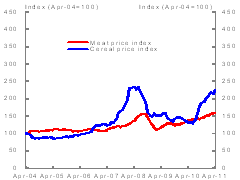
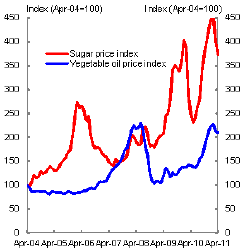
Source: FAO.
b) FICs' vulnerability to rising international food prices
The magnitude of the effects of the rising international food prices in any FIC principally depends on the level of the country's reliance on imported food. The effects of rising international food prices in the Pacific are compounded by already high transport costs and rising international fuel prices. Rising international food prices result in higher inflation, a deterioration in the external balance, increased poverty and health complications.
While resource endowments mean that many FICs will necessarily retain a high degree of import dependency, there is significant
heterogeneity across FICs when it comes to the reliance on imported food. In PNG and Solomon Islands the vast majority (around 75 to 85 per cent) of calories consumed come from domestically produced food, mostly through subsistence agriculture. Fiji and the Federated States of Micronesia (FSM), on the other hand, rely on imported food for around 60 to 70 per cent of protein consumed.2 Import reliance can also be assessed by measuring the percentage of total food expenditure that is spent on imported food; shown for selected FICs in Figure 4. Using this measure Palau and Samoa have the greatest reliance on imported food of the countries shown.
Figure 4: Proportion of food expenditure accounted for by imported food
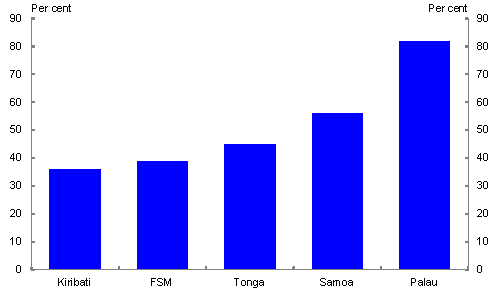
Source: McGregor et al., 2008.
However, when assessing a country's vulnerability to increasing international food prices, it is also important to consider its ability to pay for the food it imports and account for the fact that higher international food prices could potentially benefit FIC exporters of food. A 2005 FAO paper examines this issue using the ratio of food imports to total exports plus remittances (Figure 5).
Figure 5: Food insecurity using 'food import capability' indicators

Source: FAO.
More recently the United Nations International Children's Emergency Fund (UNICEF)3 developed an assessment of the vulnerability of Pacific island children and women to food price increases. This assessment considered, inter alia, the incidence of natural disasters, family size and level of social protection. The UNICEF results suggest that Tuvalu, Marshall Islands, Kiribati and Tonga have 'extremely high' levels of measured vulnerability (based on this measure).
Considering all of the above indicators, the most vulnerable FICs to international food price rises appear to be those countries with relatively small populations (Cook Islands, Kiribati, Marshall Islands, Niue, Palau and Tuvalu) that import a substantial portion of locally-consumed food and have a low export base that is unable to expand rapidly to take advantage of high global agricultural prices.
c) Wheat, beef, chicken and rice prices in local currencies4
As of April 2011, international wheat prices (measured in US dollars) are 113 per cent higher than in the trough of June 2010, but have not reached the heights seen in 2008 (Figure 6). Global wheat prices, when converted to the currencies of PNG (Kina), Fiji (Fiji dollar) and Kiribati, Nauru and Tuvalu (which use the Australian dollar as their currency), have risen by smaller degrees over the same period than US-dollar based prices. For instance, the recent rise in international wheat prices measured in Australian dollar terms — around 70 per cent over the period since June 2010 — has been around 60 per cent less than the US dollar valued price rise5, to the relative advantage of Kiribati, Nauru and Tuvalu on the assumption that they largely purchase wheat supplies from Australia.
Figure 6: Wheat price in the local currencies of PNG and Fiji; in $A terms for Kiribati, Nauru and Tuvalu;
and in $US terms for Marshall Islands, Micronesia and Palau
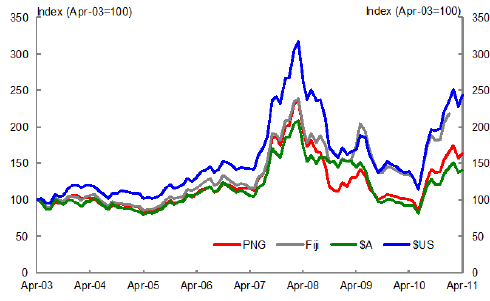
Source: Prices (World Bank), Exchange rates (IMF).
Meat, including beef, chicken and lamb, is a popular import in the Pacific island region. As with wheat, and all imported commodities, the different exchange rate regimes in place have influenced the local prices paid across the FICs. By way of illustration, the price of beef has risen significantly over the period since February 2009 when measured in $US dollar terms (up 80 per cent), while staying relatively unchanged when measured in Australian dollar terms (Figure 7). This benefits countries that are tied to the Australian dollar or that purchase beef using Australian dollars (abstracting from the influence of transport charges). As the Australian and New Zealand dollars have moved closely together over recent years, the same beneficial exchange rate impact is also true for Cook Islands and Niue assuming they purchase their beef using New Zealand dollars. Prices measured in Fiji dollars and Kina have risen faster than the Australian dollar and prices.
Figure 7: Beef price in the local currencies of PNG and Fiji; in $A terms for Kiribati, Nauru and Tuvalu;
and in $US terms for Marshall Islands, Micronesia and Palau
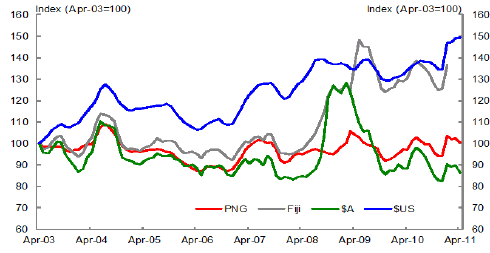
Source: Prices (World Bank), Exchange rates (IMF).
The price of chicken has been relatively stable over recent years (Figure 8), and the World Bank forecasts little change going forward.
Figure 8: Chicken price in the local currencies of PNG and Fiji; in $A terms for Kiribati, Nauru and Tuvalu;
and in $US terms for Marshall Islands, Micronesia and Palau

Source: Prices (World Bank), Exchange rates (IMF).
Rice prices spiked sharply in 2008 and have since fallen by about 50 per cent when measured in US dollar terms (Figure 9). The World Bank forecasts that the price of rice is likely to plateau over the next two years.
Figure 9: Rice in the local currencies of PNG and Fiji; in $A terms for Kiribati, Nauru and Tuvalu;
and in $US terms for Marshall Islands, Micronesia and Palau
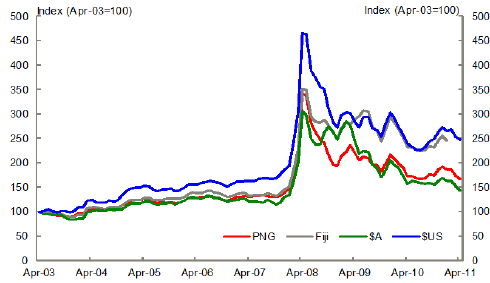
Source: Prices (World Bank), Exchange rates (IMF).
d) Conclusion on food prices
The countries that are most vulnerable to international food price increases are mainly small, remote, soil-deficient, high-import-dependent states. Some of these states, for example Nauru, Kiribati, Cook Islands, Niue, Tuvalu, and possibly others, import substantial food supplies from Australia and New Zealand. These countries have been shielded to a degree from higher international food prices assuming they use either the $A or $NZ to purchase their food imports, both of which have risen recently against the $US. As a consequence the rise in local food prices could be lower than might otherwise be the case.
Fiji obtains 75 per cent of its total food and live animals imports from Australia and New Zealand. Because the Fiji dollar depreciated against the Australian and New Zealand dollars during 2009, Fiji would have incurred higher food
costs.
Palau, Solomon Islands, Marshall Islands and the Federated States of Micronesia are likely to have been relatively adversely impacted by the recent rises in international food prices to the extent they source food supplies from the United States and transact in US dollars.
FICs with their own currencies, such as Tonga and Samoa, may have fared less adversely than the Compact States (Federated States of Micronesia, the Republic of the Marshall Islands and theRepublic of Palau) to the extent their currencies have appreciated against the US dollar.
The international food price outlook is uncertain. Ongoing weather problems in the USA and Europe could reduce production in the world's two largest grain exporters next season and this could contribute to continuing high prices during 2012. The IMF expects international non-fuel commodity prices to rise by 35 per cent in 2011 in year average terms, before stabilising in 2012. The Asian Development Bank (ADB) the World Bank and the FAO consider that the underlying upward pressures on food prices are unlikely to moderate in the near future. Oxfam predicts that real international prices of staples will rise by between 120 per cent and 180 per cent by 20306.
II. Fuel prices
a) The global situation
Just as international food prices have been surging upward over recent years, so too has the international price of fuel when measured in nominal US dollars. Over the past two years, the US dollar price of oil has risen by 195 per cent (Figure 10). Recent international oil price increases have chiefly been the result of strong demand, particularly from newly emerging economies engaged in rapid industrialisation; under-investment in exploration, production and refining; OPEC supply policies; higher exploration and production costs; and uncertainty fuelled by tensions in the Middle East. The US dollar depreciation will also have influenced the US dollar-based price index.
The sharply rising international oil price over the past two years represents a major supply-side shock to FICs, resulting in rising transportation, electricity and production costs and a higher cost of living.
Much of the fuel imported into the Pacific region, except for that destined for Australia, New Zealand and PNG, is shipped from Singapore through entrepots in Fiji and Guam7. These shipments are predominantly transacted in US dollars. However petroleum products do arrive in FICs from countries other than Singapore, including from Australia and New Zealand. Nauru currently sources oil supplies from PNG.
Figure 10: International crude oil price in US dollars

Source: World Bank.
b) FICs; vulnerability to rising international fuel prices
FICs are heavily dependent on oil — particularly diesel, kerosene and gasoline — as a source of energy, especially for power generation (25 per cent of oil use) and transportation (75 per cent of oil use). Petroleum is responsible for more than 80 per cent of energy generation in the Pacific, with countries such as Cook Islands, Kiribati, Nauru, Solomon Islands, and Tonga relying almost exclusively on oil for their commercial energy requirements. Per capita fuel use varies across the region (Figure 11), with the smaller FICs using more oil per citizen and hence being more vulnerable to international fuel price movements.
Figure 11: Per capita fuel use in the Pacific (2003)
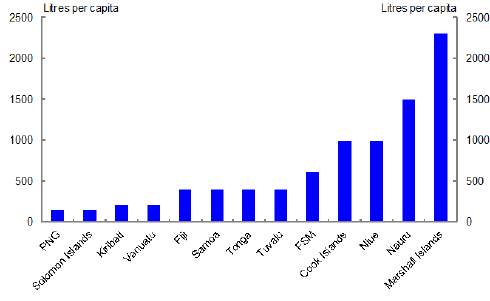
Source: Asian Development Bank.
PNG is a net exporter of petroleum and so PNG's balance of payments will benefit from the recent rises in international crude oil prices. However higher world and local prices mean that the poorer sections of the population in PNG still remain vulnerable to rising fuel prices.
For FICs other than PNG most oil, and therefore energy generation, is imported. Fuel imports as a proportion of GDP were trending upward across a number of FICs (for example, Tonga, Solomon Islands and Samoa) prior to the oil price crisis in 2008. Fuel imports are, on average, equivalent to around 10 per cent of GDP8 in the region.
In 2009 the ADB compiled an Oil Price Vulnerability Index (which combines measures like economic growth, oil intensity and budget balance9) for those FICs with sufficient data (Figure 12).
Figure 12: Oil Price Vulnerability Index (2008)
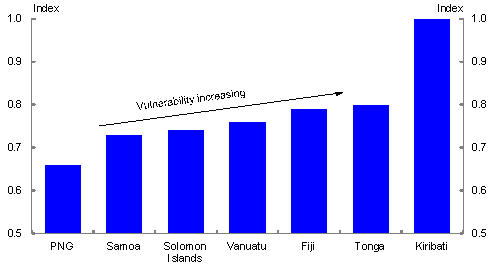
Source: Asian Development Bank.
The FICs most vulnerable to rising international oil prices are those which rely on oil for energy generation, have a low export base and no domestic oil production. Kiribati and Tonga are the most vulnerable among the seven FICs analysed by the ADB. However, the ADB notes that 'overall, when compared to 39 other developing countries, all seven Pacific nations were among the 10 most vulnerable to international oil price rises.'
c) Imported oil prices in local currencies
Petroleum products are generally traded and paid for in US dollars. These products are then on-sold to the local market in exchange for local currency.
As Figure 13 illustrates, the international oil price measured in Australian dollar terms (the currency used by Kiribati, Nauru and Tuvalu) has risen by only 70 per cent from January 2009 to April 2011. If measured in New Zealand dollars (the currency used by Cook Islands and Niue) the rise is 86 per cent. International oil price rises measured in these currencies are much less than the 165 per cent increase recorded in US dollar terms.
Figure 13: Oil price in $US terms for Marshall Islands, Micronesia and Palau; in the local currencies of Vanuatu;
in $A terms for Kiribati, Nauru, Tuvalu; and in $NZ terms for Cook Islands, and Niue
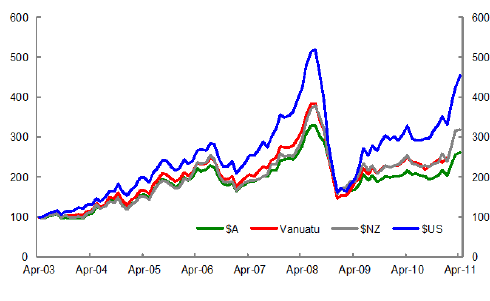
Source: Prices (World Bank), Exchange rates (IMF).
The international price of oil measured in Fiji dollars and PNG Kina has risen by a smaller degree than the international price of oil measured in Solomon Island dollars over the longer term (since April 2003), but by a greater degree than the international price of oil measured in Australian dollars and vatu terms (see Figures 13 and 14).
Figure 14: Oil price in US dollar terms for Marshall Islands, Micronesia and Palau;
and in the local cu
rrencies of PNG, Fiji and Solomon Islands
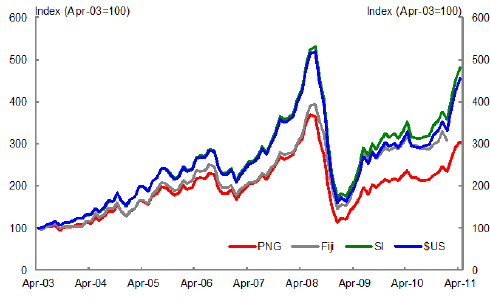
Source: Prices (World Bank), Exchange rates (IMF).
d) Conclusion on oil prices
International crude oil price increases over the past year have risen toward the levels experienced during the last oil price shock in 2008. The region's strong reliance on oil for energy generation means that any international oil price increases are felt widely throughout the FIC region. Generally, exchange rate considerations aside, the most vulnerable FICs to rising fuel prices include the Marshall Islands, Nauru, Kiribati and Tonga.
Countries that purchase oil supplies in US dollars, are likely to have been relatively substantially impacted. FICs that have their own sovereign currency and have seen their local currencies appreciate against the US dollar will have benefited in relative terms (e.g. Samoa, Tonga and, most recently, Solomon Islands10). To the extent that other FICs were able to pay for their imported oil supplies in Australian or New Zealand dollars, the adverse effects of rising international oil prices could have been ameliorated over the past two years.
The outlook for international crude oil prices is uncertain. The IMF expects international crude oil prices to rise by 25 per cent in 2011 in year average terms, declining slightly in 2012. Any substantial unexpected slowing in global economic activity could take prices sharply lower. The International Energy Agency (IEA) expects average IEA crude oil prices to rise from just under $US60 per barrel in 2009 to $US113 per barrel (in 2009 dollars) by 203511.
III. Summary of food and fuel price vulnerability
The main findings from the above analysis are that, exchange rate considerations aside, the most vulnerable FICs to international food price rises include Cook Islands, Kiribati, Marshall Islands, Niue, Palau, Tuvalu, and likely Nauru. This mainly reflects their small populations, import dependency and low export bases.
As well, exchange rate considerations aside, the most vulnerable FICs to international crude oil price rises appear to be Kiribati, Marshall Islands, Nauru and Tonga. This mainly reflects their high import dependency and fuel use per capita.
Marshall Islands, Kiribati, and most likely Nauru are highly vulnerable to both food and fuel price rises.
Exchange rate arrangements, local exchange rate developments and the currency used to pay for purchases of imported oil and food can be important determinants of the severity of international price rises on local FIC economies. Generally those countries with appreciating currencies have suffered less than those with depreciating currencies.
IV. Macroeconomic effects
Where countries are vulnerable to international food and fuel price rises, they generally experience higher inflation, a deterioration in the balance of payments and lower real incomes.
Inflation effects
Across the Forum island region, food prices account for around 45 per cent of their consumer price index baskets on average.
In 2008 surging food and fuel prices contributed to a rise in inflation across the Forum island region, lifting inflation (on average) from 2.5 to 12 per cent per annum.
The pass-through of international crude oil price rises into domestic inflation was almost complete but the pass-through of food price increases was smaller as some FICs reduced tariffs on food or introduced price controls12.
Higher food and fuel prices, in combination with other forces, contributed to rising inflation in FICs during 2010 and into 2011, but inflation is expected to be relatively subdued across the Pacific later in 2011 and in 2012 (see Figure 15).
Based on IMF forecasts, inflation is expected to pick up by around two or three percentage points in Solomon Islands, Tuvalu, Kiribati, PNG, Tonga and Nauru in 2011. The ADB expects a broadly similar-sized rise in inflation in the Marshall Islands. The expected rise in inflation in these countries is partly or largely due to higher international commodity prices (the effects of which, in some FICs, has been contained somewhat by currency appreciation).
FICs have relatively high levels of liquidity (which influences inflation) in their banking systems at the present time, but inflationary price pressures have been subdued by flat GDP (in a number of FICs) and weak demand for loans by the private sector. With liquidity high, and food and fuel prices strong, there may, nevertheless, be upside risks to the inflation forecasts. Over the year to May 2011, inflation was running at higher than forecast in Fiji. Inflation is also above forecast in Solomon Islands and Tonga, over the year to April 2011.
Figure 15: Recent inflation experience and forecasts
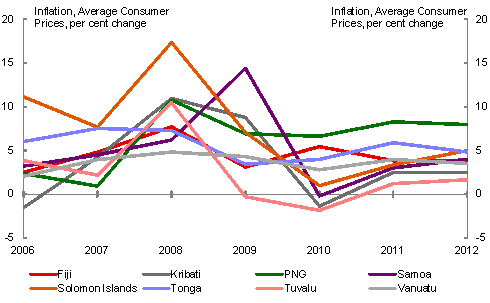
Source: IMF.
Balance of payments effects
Generally, while rising international food and fuel prices will be working to weaken FICs' balance of payments positions, large adverse balance of payments movements are not expected in the period ahead, partly due to subdued domestic demand. Higher levels of foreign currency reserves may provide a buffer in some FICs.
During 2010 and into 2011, the balance of payments in PNG has benefited from higher commodity export prices for mining products, crude oil, agriculture and logs. Nauru has benefitted from higher phosphate prices, and rising international log prices assisted the balance of payments of Solomon Islands.
FICs with their own currencies have scope to adjust their exchange rates in response to external price shocks. FICs that have adopted another currency as their own do not have this capacity.
Lower real incomes, poverty and budget effects
Rising food and fuel prices have their greatest adverse effects on the poorest urban households, those in rural areas without access to land, those families that are net consumers of food, and those outer-island dwellers vulnerable to higher fuel and transport costs. As prices rise, and if cash incomes are unchanged, then living standards fall, although the effects of rising import prices may be mitigated if individuals can substitute the more expensive imported products with cheaper locally produced products (including, for example, fish). In some cases, however, family stress and poverty increases, nutrition can suffer, malnutrition may spread and health costs could be raised. Policy responses to such developments generally involve increased budget expenditures.
V. Policy Principles
Governments need to review possible policy responses to mitigate, where necessary, the adverse economic effects of rising international food and fuel prices.
a) Examples of policy responses to the 2008 food and fuel price spike in FICs
A range of different policies were employed across the Pacific in the wake of the surge in food and fuel price increases in 2008. These policies included:
- Reduced tariffs on food, fuel and poultry feed, fishing equipment and other agricultural inputs; lower taxes on food and fuel; price controls; i
ncreased subsidies on food, fuel and electricity; delays in raising electricity prices and other state enterprise prices. - Encouragement to buy locally-produced goods and cultivate garden crops; training programs to transform breadfruit into flour; promotion of root crops, coconut replanting, organic farming and virgin oil production; fuel rationing.
- Increased income tax thresholds, removal of excise duties on sea and air transport operations.
- Increased foreign aid aimed at food and fuel provision, declaration of a state of emergency.
- Loans to increase fuel storage capacity.
b) Examples of policy responses to recent 2010-2011 escalation in oil and food prices
A recent UNICEF publication13 identifies recent policy measures introduced by a number of FICs, viz:
- Vanuatu has a preferential tax rate on preferred food items, the duty rate on essential food items has been reduced and copra price subsidies have been increased.
- Tonga is controlling the cost of flour and fuel.
- Kiribati has introduced price controls for basic food items, ensures cargo shipments to address food shortages in outer islands and has been supporting garden production of nutritious foods.
- Fiji is now setting prices for a range of essential items. However VAT was increased by 2.5 per cent in February 2011 and canned fish (widely consumed) is now also subject to a fiscal duty of 15 per cent.
Solomon Islands recently appreciated its currency in part to counter rising international food and fuel prices.
The World Bank is providing 62,000 residents of the outer islands of Kiribati with emergency food supplies.
The IEA is releasing 60 million barrels of crude oil from emergency stocks.
The World Bank is supporting the development of an Agricultural Price Risk Management product for potential application in developing countries, focussing initially on Latin America and Southeast Asia.
The G20 has advanced a series of work streams on commodity price volatility: see details at Attachment A. G20 Agriculture Ministers have agreed to an 'Action Plan on food price volatility and agriculture' which will be submitted to Leaders at their Summit in November 2011. As well, G20 Agriculture Ministers have requested that relevant international institutions develop a proposal for a pilot program for regional emergency humanitarian food reserves. The pilot program would cover a limited group of countries, selected from Low Income Food Deficit Countries as determined by FAO and Least Developed Countries as defined by the United Nations General Assembly in a particular region. Some FICs are in these country groupings.
Australia contributes to Pacific food security through investment in the Pacific Horticulture and Agricultural Market Access Program, the Pacific Agricultural Research Development Initiative and support for various fisheries initiatives through the Secretariat of the Pacific Community and Forum Fisheries Agency.
c) General policy principles
The international experience has led various institutions such as the IMF, ADB, World Bank and UNICEF to suggest a range of principles to guide decision-making to address rising food and fuel prices14. These include the following types of approaches:
Resource allocation policy
At the broadest level, when faced with multiple food and fuel price shocks and higher price levels (both relative and absolute), a well functioning, undistorted price system is desirable.
It would also be beneficial to remove supply bottlenecks and encourage greater domestic production (where possible) by: investing in transport infrastructure; improving efficiency in the transport sector; facilitating land reform; improving agricultural productivity and further developing irrigation and reticulation where appropriate, in conformity with sound cost/benefit principles.
Some FICs could benefit from: the development of clearer, comprehensive energy policies with the objectives of achieving greater fuel efficiency (including in the transport sector and through bio-fuels); the development of non-petroleum-based and renewable energy production, including hydro-power, wind-power and solar energy; and establishing the feasibility of erecting oil storage facilities.
These various resource allocation policies could potentially broaden the economic base and reduce excessive oil and import dependency. While FICs should not invest in inefficient or uneconomic industries, such reforms could increase the efficiency of existing industries and open-up new areas of competitive advantage.
Policies to address inflationary effects
General inflationary pressures resulting from rising food and fuel prices need to be carefully monitored. Reducing excess liquidity and tightening monetary policies may be necessary to avoid and counter second-round food and fuel price impacts on inflation and inflationary expectations.
It may be advantageous to review and rationalise existing oil procurement arrangements and oil pricing policies, including development of options for competitive tendering and obtaining fuel at lower prices than in existing contractual agreements.
Encouraging competition and reducing barriers to entry in key production, transport and marketing sectors may help minimise the impacts of high food and fuel prices on consumers.
Where feasible, greater use of hedging mechanisms may enable traders and users of commodities to minimise the effects of price volatility. However, some hedging instruments, for example, foreign exchange futures, are not widely available in the Pacific island region.
Market uncertainty about food stocks may work to maintain high prices. Greater market and related data transparency may be of general benefit.
Price controls on food and fuel prices and ceilings aimed at controlling inflation are distorting and limit domestic responses to higher import prices by reducing the attractiveness of local products and limiting investment in domestic production.
Exchange rates, trade and the balance of payments
In the face of external price shocks adequate exchange rate flexibility may help avoid real exchange rate overvaluation or undervaluation and minimise adverse competitiveness or inflation impacts respectively.
Generally, all else remaining equal, appreciating exchange rates reduce the domestic inflation effects of international food and fuel price increases but weaken general trade competitiveness. Depreciating currencies increase adverse domestic inflation effects but improve general trade competitiveness. Clearly for FICs with their own currencies there is a trade-off to be made between trade and inflation objectives in response to external price shocks.
As noted in the outcome of the Pacific Islands Forum Energy Ministers' Meeting (2011), FICs may want to consider exploring alternative cost-effective and reliable oil supply sources while at the same time reviewing current oil pricing practices and policies.
An open global trading system is desirable. Reducing tariffs on food and fuel and agricultural inputs may be beneficial in ameliorating increases in prices and costs, but there would be an associated adverse impact on the budget balance, and an incentive for continued import dependency.
The use of export restrictions to lower or contain domestic prices will lower the incentive to invest domestically to boost supply, reduce global food supplies and threaten world food security.
Fiscal policy
Food and fuel subsidies may be problematic as they can be poorly targeted, dampen price signals, and may not be based on need and represent an additional call on scarce budget resources.
Any reductions in consumption taxes on food and fuel need to be carefully considered against
the cost to government revenue, administrative complexity and price distortions.
As direct taxes in FICs are likely to be paid mainly by the relatively well off members of their societies, direct tax reductions may be inequitable, mainly benefiting the rich.
Any budget measures must be carefully judged and take into account the overriding need to maintain fiscal sustainability.
FICs may need to review incentive structures and regulations that distort food and oil consumption and production.
Poverty alleviation policies
Where FICs have adequate systems in place, governments may consider expanding or strengthening monitoring programs, safety nets, targeted cash transfers and nutritional programs.
Given the importance of strong family ties, informal safety nets and the informal economy in offsetting shocks in FICs, governments should carefully assess needs and the impact of different policy options.
References
Asian Development Bank 2009, 'Taking Control of Oil: Managing Dependence on Petroleum Fuels in the Pacific', Pacific Studies Series.
Food and Agriculture Organisation of the United Nations 2011, FAO Food Price Index.
International Monetary Fund 2011, 'Pacific Island Countries: Vulnerabilities to Commodity Price Shocks', Regional Economic Outlook, Asia and Pacific, Managing the Next Phase of Growth, World Economic and Financial Surveys.
International Monetary Fund 2011, Exchange Rate Archives.
International Monetary Fund 2011, Database.
International Energy Agency 2010, 'Recent policy moves a start, but much stronger action is needed to accelerate the transformation of the global energy system, says the IEA's latest World Energy Outlook', Press Release, 10(15), London.
McGregor, A, Bourke, R M, Manley, M, Tubuna, S, and Deo, R, 2008, Pacific Island Food Security, Situation, Challenges and Opportunities, paper prepared for Pacific Islands Ministers of Agriculture and Fisheries Meeting in Apia, Samoa.
Oxfam 2011, Growing a Better Future: Food Justice in a Resource-Constrained World.
Secretariat of the Pacific Community 2011, 'Communique of the Inaugural Regional Meeting of Ministers of Energy, Information and Communication Technology (ICT) and Transport', Noumea.
UNICEF 2011, 'Situation Monitoring: Food Price Increases in the Pacific Islands', UNICEF Pacific Working Paper.
World Bank 2011, Commodity Price Database.
World Bank 2011, Commodity Price Data, Global Economic Monitor.
Attachment A: G20 work on commodity price volatility
Addressing commodity price volatility and food security are key G20 priorities. Work on commodity price volatility is progressing in various G20 work streams (see below). Recommendations will be presented to G20 Leaders for consideration at the Cannes Summit on 3-4 November 2011.
G20 Study Group on Commodities
This Study Group is considering the drivers of commodity prices (physical and financial), macroeconomic and other impacts of commodity price volatility, and the linkages between the physical and financial markets for commodities. The Study Group will lay the groundwork for subsequent policy discussions by finance ministers.
Development Working Group (DWG)
The DWG was tasked with mitigating risk in price volatility and enhance protection for the most vulnerable. The international organisations (the Food and Agriculture Organisation, International Fund for Agricultural Development, the International Monetary Fund, the Organisation of Economic Cooperation and Development, the United Nations Conference on Trade and Development, the World Food Program, the World Bank, the World Trade Organisation, the International Food Policy Research Institute and the United Nations High Level Task Force on the Global Food Security Crisis) were tasked to 'develop options for G20 consideration on how to better mitigate and manage the risks associated with the price volatility of food and agricultural commodities without distorting market behaviour, ultimately to protect the most vulnerable.' Recommendations from this paper have shaped aspects of the proposed agriculture action plan to be issued by G20 Agriculture Ministers in June.
G20 Agriculture Ministers meeting
A one-off Agriculture Ministers' meeting will consider price volatility in agricultural commodity markets. Agriculture Ministers will issue a communiqué and put forward an action plan for endorsement at the G20 Leaders' meeting in November. A key focus will be on improving the transparency of physical agricultural commodity markets, and increasing long-run agricultural productivity.
Supervision and regulation of commodity derivatives markets
Further work is underway on the supervision and regulation of commodity derivatives markets and ways to improve market integrity and efficiency. G20 Finance Ministers and Central Bank Governors tasked the International Organisation of Securities Commissions (IOSCO) to undertake work to strengthen transparency and address market abuses. IOSCO intends to revise and improve its best practice guidelines for the regulation and supervision of commodity derivatives markets. IOSCO also continues to work on the development of a trade repository for financial oil contracts.
Financial Stability Board (FSB) Over-the-Counter (OTC) Derivatives Market Reforms
The G20 has called for 'all standardised OTC derivative contracts to be centrally cleared, and to be traded on exchanges or electronic trading platforms where appropriate.' The FSB has proposed recommendations for practical implementation to improve transparency, mitigate systemic risk, and protect against market abuse in commodity derivatives markets.
G20 Fossil Fuel Price Volatility Working Group
This Working Group is focused on physical markets and linkages with financial markets. The Working Group is considering ways to improve reporting on oil data. The Working Group will consider a report from international organisations on price drivers in coal and gas markets. The Working Group will also assess a report on how oil spot market prices are assessed by oil price reporting agencies.
1 The authors are from International Finance and Development Division, the Australian Treasury. This article has benefited from comments and suggestions provided by Patrick Colmer, Kelly Trudgen, Sigi Gartmann and Sharon Traucki. The views in this article are those of the author and not necessarily those of the Australian Treasury
2 See 'Pacific Island Food Security, Situation, Challenges and Opportunities', Andrew McGregor, R. Michael Bourke, Marita Manley, Sakiusa Tubuna and Rajhnael Deo, September 2008.
3 'Situation Monitoring: Food Price Increases in the Pacific Islands', UNICEF, March 2011.
4 There are a wide variety of currency arrangements across Forum island countries. Kiribati, Nauru and Tuvalu have adopted the Australian currency as their own; Cook Islands, and Niue adopted the New Zealand dollar; Marshall Islands, Micronesia and Palau adopted the United States dollar; Solomon Islands is closely tied (de facto peg) to the United States dollar; Tonga, Samoa, Vanuatu and Fiji have their own basket-based fixed exchange rates; and PNG has a managed floating currency.
5 This analysis assumes that the only difference between food prices in different countries is the exchange rate. It assumes the international price is
prevalent in all countries. As such the analysis does not address transport cost differences, refining distribution and marketing costs, taxes, price controls, other regulatory arrangements and the effects of local events (for example, weather) on prices quoted on markets in different countries.
6 See 'Growing a Better Future: Food Justice in a Resource-Constrained World', Oxfam, 1 June 2011.
7 See 'Taking Control of Oil: Managing Dependence on Petroleum Fuels in the Pacific', Asian Development Bank, Pacific Studies Series, 2009.
8 'Pacific Island Countries: Vulnerabilities to Commodity Price Shocks', Regional Economic Outlook, Asia and Pacific, Managing the Next Phase of Growth, IMF, April 2011.
9 The eight measures used are: balance of payments: current account; budget balance; import cover; oil import dependence; GDP per capita; oil intensity of GDP; real GDP growth rate; share of oil in primary energy consumption.
10 Solomon Islands government announced a 5 per cent appreciation of the Solomon Islands dollar on 14 June 2011.
11 See IEA, Press Release, 10(15), November 2010.
12 'Pacific Island Countries: Vulnerabilities to Commodity Price Shocks', Regional Economic Outlook, Asia and Pacific, Managing the Next Phase of Growth, IMF, April 2011
13 Situation Monitoring: Food Price Increases in the Pacific Islands, UNICEF, March 2011
14 See, as well, the Communique of the Inaugural Regional Meeting of Ministers of Energy, Information and Communication Technology (ICT) and Transport, Secretariat of the Pacific Community, Noumea, New Caledonia, 4-8 April 2011.